Namuka-I-Lau

|
Namuka-I-Lau
The Southern Lau is comprised of 16 islands
and 20nm north from Vulaga lay our next destination – Namuka-I-Lau. Light breezes and blue sky’s swept us
northwards and provided excellent visibility through the reef pass into the
lagoon early afternoon. After Vulaga,
Namuka is probably the second “most visited” island in the Southern Lau but
even then, many cruisers sail past keen to reach their next destination. Consequently, we were delighted to be the
only boat there and have this gorgeous anchorage to ourselves.
Namuka is yet again home to crystal
clear Fiji water – so clear that in certain light the water becomes invisible
and the dingy appears to be “floating” in mid-air behind the boat.
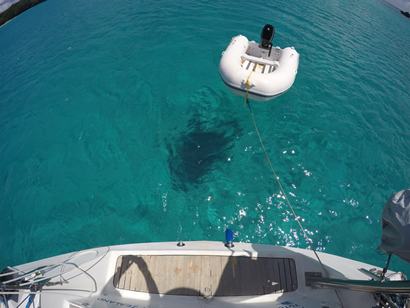 
However, before we could swim and explore
we needed to head into the village to do Sevu Sevu with the Chief and request
permission to stay. Also on board were
packages and letters from another cruiser to take to friends on the island. It’s always good to have an “in” to a village
in a new destination so we were looking forward to meeting the locals.
Next day, armed with a large bunch of
yagona (kava) and the “mail delivery”, we set off. There is only one village on Namuka – and
it’s a good hour walk each way on a very over-grown, often muddy but thankfully
mostly flat track. Needless to say,
after a couple of weeks we’re feeling fitter for all the walking, but it
remains to be seen whether our feet will ever return to normal colour - they
seem permanently stained with the orange mud we have tramped through on so many
occasions. Arriving in the village,
which turned out to be the largest we’d seen with around 300 people living
there, there didn’t seem to be anyone around.
We quickly spotted the Nurse’s station – always a good place to start to
find out where the headman might be so we can track down the Chief and do our
introductions. It turned out the reason
why no-one was around was that a villager had died the day before and they were
in the process of burying him right then – things have to be done pretty
quickly in the tropical heat. Shock
horror – the recently deceased was the husband of the person we were delivering
the mail to, so after a very brief Sevu Sevu we decided to come back another
day. This was despite everyone we met saying
that it was fine to stay, we just didn’t feel comfortable – it was too much of
an intrusion in our minds. Fijians being
Fijians however have a different view of “going celestial” (passing away). There will be plenty of tears and sadness,
but the flip side is their total conviction that everyone has “their time” and
whoever’s involved is now “with the lord” and life just needs to go on. It’s the natural process of life but the
levels of healthcare here means it’s much more a part of life than we are used
to.
I’m sure it’s true of all islands, but
particularly in the Lau, every island has a different speciality – something
they do particularly well and are “world famous in Fiji” for. Vulaga has their sailing canoes and wood-carving,
and in Namuka it’s their masi (tapa).
When we walked back into the village after a couple of days, it appeared
that life had returned to normal as we “heard” the village long before we even
saw it this time. The sound was a
constant sharp banging, clearly not a drum and plenty of it. It was the sound of women beating the masi,
something they do every day here – but more about that later. The “village telephone” had worked very effectively
since our last visit and the family we were coming to visit with the mail
delivery were expecting us. The newly
widowed Sofaia warmly invited us into her family and man – there was a lot of
them! The custom here at the time of a
death is that the whole family comes together, and after the burial which is
almost immediate, the family then must stay together for another 10 days before
they have the real funeral. During this
10 day period they all eat together, all the women sleep together in one bure
(house) and all the men in another.
Given the size of the average family here – 6 and 7 children is not
uncommon, this quickly escalated into meals for 40 or 50 people – I think we counted
up to 30 children alone at one point – so what was a couple of “extras”?

Namuka traditions for a death also
involve piling many many mats and decorated masi onto a grave on the “10th
night”. As it turned out, Sofaia was one
of the “master masi makers” – a true artisan and there was a “masi frenzy”
going on as the village women mobilised themselves into making the mats needed
for the funeral. The level of activity
was impressive. Masi is a pretty small
straggly kind of a plant and after it’s been stripped of its bark and soaked in
water, the women beat it over a long curved trunk kind of table that seems to
be in everyone’s kitchen. This is the
sound you can hear for miles. It’s very
very loud inside a corrugated iron hut and there’s no workplace safety people
with noise meters here – we’re surprised they’re not all deaf!
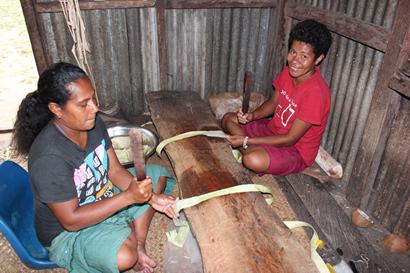
As you can see in the photos above, beating the skinny little masi trunk only yields a thin strip of paper-like cloth that is then dried. These strips are joined together using a potato-like root that boiled and cut in half provides a starch glue. The pieces keep being joined until you get the size of the mat you want. 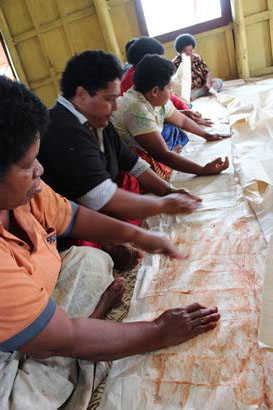 The design is then measured and marked out
and the decoration takes form.
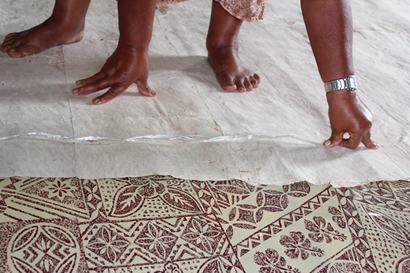
The black ink is from a certain tree
bark boiled and the red/brown paint is mud from the neighbouring island of
Komo. Larger designs like the mat below
are drawn freehand and the smaller more intricate designs are from
stencils. The ladies guard their
stencils and their families designs quite fiercely – even locking them away
when not using them.

The stencilled areas in black are done
first and then certain areas filled in with the komo mud later. 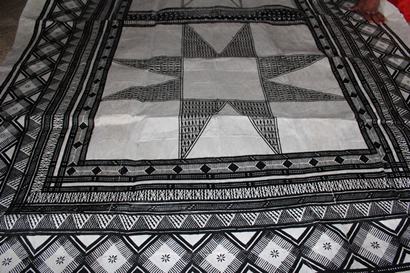
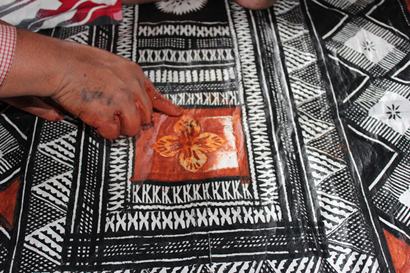
Even with the priority of completing the
masi required for the funeral, Sofaia insisted on making a series of smaller
mats (boat sized) for us. We spent days
with her and the ladies fascinated with the process and impressed with their
talent. They chat and tell stories all
day and in true Fijian style they are teasing each other and laughing all day
long it seems.
Like all islands, Sunday is church day
and it was the familiar sounds of the village drums rather than masi beating
that greeted us on those days. Being
such a large village, Namuka has a very large church which turned out to have
excellent acoustics. It became apparent
that this island wasn’t just expert at masi making but they were also
exceptional singers. All Fijians sing in
multiple harmony beautifully, but these guys took it to a whole new level. They had 3 separate choirs including a
children’s choir that sang at various times.
On Father’s Day most of the men got up from their seats and gathered in
a large semi-circle at the front of the church and sang. It was captivating and the noise deafening –
no micro-phones required. You would
never imagine that such large men (they are huge in height and
width), have not only the deep booming voice you’d expect from that stature,
but some also have quite high almost Bee Gee like voices - so when they all
sing together – calling and answering each other it puts the hairs up on the
back of your neck.
Sunday represents the largest lunch of
the week and it was just as well we were walking a couple of hours a day
because we were doing some serious eating.
The word “Namuka” means “big chewers” in Fijian – so unexpectedly they
had pretty impressive appetites. We were
thankful it wasn’t a couple of hundred years ago or we’d be on the menu!! With all the family around all day, Carl somehow
became the official family portrait photographer. Due to not many boats coming to Namuka, the
really small children hadn’t got close to a Kaipalagi (white people)
before. They were OK if their parent was
close-by and they could just stare at us, but if Mum or Dad were nowhere to be
seen they screamed and cried – and once one started ……..

After we promised that we would get
photos printed back in NZ and post them, Sofaia organised all her children and
grandchildren, aunts god-parents and who knows else into little groups. Carl, Carl she would say – could you just
come over here for a minute please ……… It will be a big package arriving their
way hopefully before Christmas if the ferry sticks to its schedule. The photo below is Sofaia and all her
grandchildren!
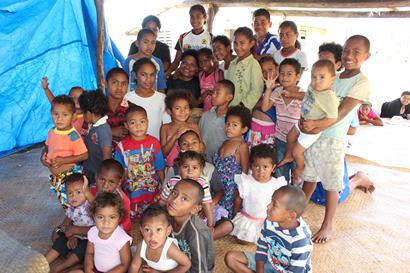
Our contribution to Sunday lunch was
always something sweet. The way to any
Fijian’s heart is through sugar. They
loved the things I baked so much that when I claimed they were very easy –
using ingredients they have – I was asked to conduct a cooking demonstration. So on the appointed day, we show up with the
goods and the recipes and they bought one of the few gas ovens on the island into
Sofaia’s bure.
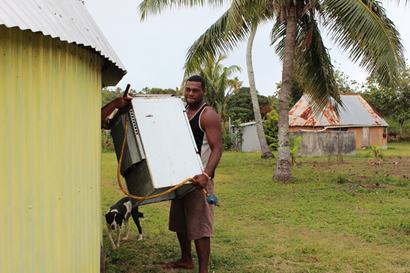
The first oven didn’t work (yikes -
really strong smell of gas- lots of Ka Bang jokes and nervous expresions ! )) –
no worries – they went and just got another one!
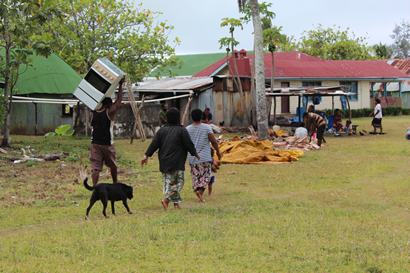
So after a large pot of popcorn to get
everyone in the mood – we made a nice gooey chocolate fruit slice made with
crushed superwines, butter, cocoa, fruit cake mix etc etc – All in a saucepan
and then into the fridge - I had quite an audience.
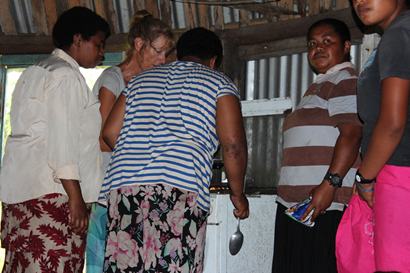
I don’t think anyone actually had a
fridge, but there were a couple of freezers around that ran for a few hours a
day when the village generator was turned on - so in it went into one of those
– somehow we didn’t think it was going to last long anyway. 
By now we were so much a part of the
furniture that if Sofaia decided we’d left it too late to walk the hour or so
back to the boat – coins were passed around, petrol appeared from somewhere and
a fibre boat was dispatched to deliver us back to our “home bay”. No amount of trying to pay or saying we could
still walk would work – fibre boat it was.
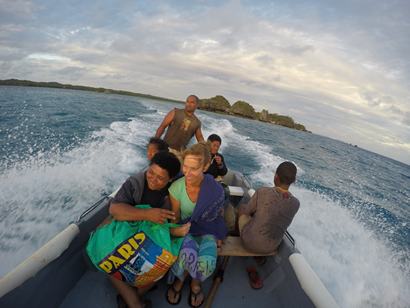
The last time we were “delivered” back
to our home the fibre boat stood off a few meters and they sang the traditional
Fijian song of farewell “Isa Lei” (in 4 part harmony naturally – now we know
why so many people wanted to come along for the ride). We’re getting so soft – we just stood on the
beach with tears rolling down our faces once we saw the tears rolling down
theirs – the “get down and love your brother” stuff is a bit much for us
honky’s some daysJ They waved until they couldn’t see our boat
anymore. Now that Navara had the
reputation as an “inter-island postal delivery service”, we left the next day
loaded with clothes and masi to deliver to Kadavu where three of Sofaia’s
children are at boarding school. The
masi was for the Kadavu School Principle who had never received anything by
private boat before and she was pretty impressed.

As a final footnote – at times of grieving,
the house of the grieving family is the only house where kava is drunk until
the 10th night. The grieving
family then effectively becomes the centre of village life for the mourning
period. This ensures that the family
members are never left alone, and they are supported by the other
villagers. There isn’t any grief
counselling available here but they seem to have a pretty good system
going. While I was hanging out with the
women masi- making and cooking, Carl often ended up with the men for the
afternoon – gossiping around the tanoa (kava bowl) as men tend to do. These people in the outer islands are often
very charming and innocent as to the worries of the world. Although they knew every All Black by name and
could give detailed opinions on their relative strength’s and weaknesses - no-one
we met knew who ISIS or Islamic State was or that there was a refugee crisis in
Europe. One kava circle conversation
will forever stick in Carl’s mind with men of about his age who don’t get to
talk with many kaipalagi. This
particular conversation thread had started with Carl commenting how many black
tip reef sharks there are here (we don’t mind white tips, but black tips can be
flighty and aggressive), and a couple of men hoisted their sulus to show
impressive scars of where they had been bitten by black tips – mostly whilst
spear fishing, but pretty gruesome all the same. This naturally led to what kind of dangers
did we have in NZ? Snakes? No – no snakes……. Crocodiles? No – no
crocodiles……… this was very surprising to one older gentlemen who says “what –
no crocodiles”? –“ that’s the first time I heard there are no crocodiles in NZ
– I was sure you had crocodiles!! ……..What
about Lions? Do you have Lions in NZ?”
……….”
Carl did a good job keeping a straight
face and now I know what he’s thinking when he smiles as people ask about where
we come from. A few days stay at
Namuka-I-Lau turned into 2 weeks. The
“postal ship Navara” made her delivery in Kadavu before rushing to Suva to get
our Visa’s extended so they don’t’ deport us!!
|